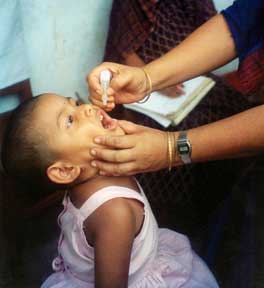Poliomyelitis, commonly known as polio, is a highly infectious viral disease that primarily affects young children and can lead to irreversible paralysis or death. Caused by the poliovirus, the disease has been significantly curtailed through widespread immunization. Poliomyelitis vaccination remains the cornerstone of global polio eradication strategies endorsed by the World Health Organization (WHO).

Understanding Poliovirus and Its Transmission
Poliovirus belongs to the Enterovirus genus and is transmitted via the fecal-oral route, often through contaminated water or food. Following ingestion, the virus multiplies in the intestine and can invade the nervous system, resulting in neuromuscular complications.
Clinical Manifestations
- Asymptomatic (90–95%): Most infections are silent
- Abortive poliomyelitis: Mild illness with fever and sore throat
- Non-paralytic poliomyelitis: Aseptic meningitis symptoms
- Paralytic poliomyelitis: Flaccid paralysis, mostly in the lower limbs
- Post-polio syndrome: Late muscle weakening decades after recovery
Types of Poliomyelitis Vaccines
Two main types of vaccines are used in immunization programs:
Oral Polio Vaccine (OPV)
- Composition: Live attenuated poliovirus (types 1, 2, and 3)
- Administration: Oral drops
- Advantages:
- Induces strong mucosal immunity
- Interrupts community transmission
- Cost-effective and easy to administer
- Risks:
- Rare occurrence of vaccine-associated paralytic poliomyelitis (VAPP)
- Circulating vaccine-derived poliovirus (cVDPV) in under-immunized communities
Inactivated Polio Vaccine (IPV)
- Composition: Killed poliovirus strains
- Administration: Intramuscular or subcutaneous injection
- Advantages:
- No risk of VAPP
- Safe for immunocompromised individuals
- Limitations:
- Requires trained personnel
- Higher cost compared to OPV
- Less effective in inducing intestinal immunity
Global Polio Immunization Schedule
WHO recommends a sequential schedule involving both OPV and IPV to maximize protection:
| Age of Child | Vaccine | Dose Type |
|---|---|---|
| Birth | bOPV | Zero dose |
| 6 weeks | bOPV + IPV | First dose |
| 10 weeks | bOPV | Second dose |
| 14 weeks | bOPV + IPV | Third dose |
| 9 months | bOPV | Booster |
| 16–24 months | IPV | Booster |
Some countries have transitioned to IPV-only schedules, especially those with high routine immunization coverage and zero cVDPV risk.
Mechanism of Vaccine-Induced Immunity
Both OPV and IPV induce protective antibodies, though via different pathways:
- OPV: Generates intestinal IgA, halting transmission in the community
- IPV: Stimulates serum IgG, preventing CNS invasion and paralysis
Effectiveness and Safety of Polio Vaccination
Efficacy Rates
- OPV: 3 doses provide ~99% protection against paralysis
- IPV: 3 doses provide ≥95% protection against all poliovirus types
Safety Profile
- Both vaccines have excellent safety records
- OPV: Rare VAPP (approximately 1 case per 2.7 million doses)
- IPV: Minimal side effects such as injection site pain or fever
Global Eradication Initiatives and Impact
Global Polio Eradication Initiative (GPEI)
Launched in 1988, GPEI is a public-private partnership led by WHO, Rotary International, CDC, UNICEF, and the Bill & Melinda Gates Foundation. Major milestones include:
- Wild Poliovirus Type 2 declared eradicated in 2015
- Wild Poliovirus Type 3 declared eradicated in 2019
- Over 99% global reduction in cases since 1988
Remaining Endemic Countries
As of recent years, Afghanistan and Pakistan remain the last strongholds of wild poliovirus transmission due to:
- Political instability
- Vaccine hesitancy and misinformation
- Inaccessibility of high-risk regions
Challenges in Polio Vaccination and Eradication
- Conflict zones: Impede healthcare worker access
- Vaccine refusal: Driven by cultural, religious, and misinformation factors
- Cold chain logistics: Crucial for maintaining vaccine potency
- cVDPV outbreaks: Resulting from prolonged OPV usage in under-immunized areas
Innovations and Strategies for Future Success
Introduction of Novel Oral Polio Vaccine Type 2 (nOPV2)
- Genetically stabilized to reduce mutation risk
- Emergency Use Listing by WHO
- Used in outbreak response in multiple countries
Transition to IPV-only Strategies
- Ensures safety from vaccine-derived strains
- Requires global capacity building for IPV production and administration
Environmental Surveillance
- Sewage sampling detects silent transmission
- Complements clinical case surveillance systems
Frequently Asked Questions:
Is polio vaccination still necessary today?
Yes. Until global eradication is certified, continued immunization is critical to prevent re-emergence.
Can polio return if vaccination stops?
Yes. Discontinuation of vaccination programs could lead to resurgence, even in polio-free areas.
How many doses of polio vaccine are needed?
At least 4–5 doses are required for complete protection in early childhood, with boosters recommended.
Are there side effects of polio vaccines?
Mild fever or pain is possible. OPV has a very low risk of VAPP, and IPV has no serious known adverse effects.
Can adults receive polio vaccines?
Yes. Adults traveling to endemic regions or working in healthcare may require boosters.
Poliomyelitis vaccination remains one of the most effective public health interventions. Through robust immunization schedules, integrated surveillance, and strategic global partnerships, humanity stands on the verge of eradicating this crippling disease. Sustained efforts, adaptive strategies, and global cooperation are imperative to ensure that polio becomes the second human disease, after smallpox, to be eradicated from the face of the Earth.